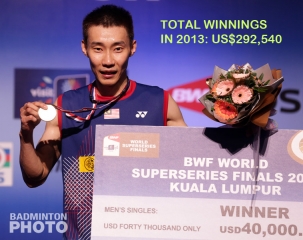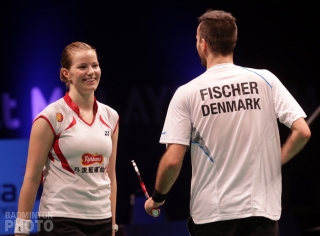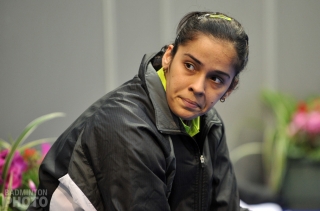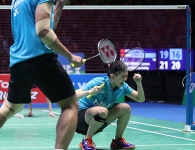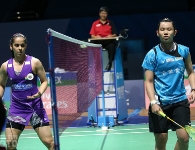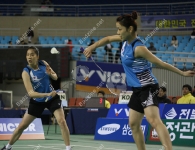Badzine reveals today the list of top 50 badminton earners based on the prize money which was awarded during the 2013 season for all BWF tournaments. Lee Chong Wei tops the bill as expected in the men’s category, with almost US$300,000 in cash while double Olympic champion Zhao Yunlei takes the most lucrative spot in the women’s category thanks to her incredible run in both mixed and women’s doubles events this year.
Photos: Badmintonphoto
The statistics reveal clearly that the Asians are very much on top of the chart as only one European is in the top 10 – Christinna Pedersen (photo), ranked 7th with US$127,596. The Dane fared really well with both her mixed doubles and women’s doubles partner and her double win at the Superseries Finals in Kuala Lumpur – where she pocketed US$42,000 that same day – made a difference. Her partner Joachim Fischer Nielsen stands at #21 with US$72,888 won in 2013 while the first singles European shuttler, Jan O Jorgensen, comes in at #31.
China, as expected, is the country which comes on top of the winnings with 7 players in the top 15.
Some surprise however, with very popular players expected to top the bill – such as India’s Saina Nehwal (photo), who only pocketed US$43,408 this year and clearly contrasts with the outstanding endorsement contracts reported on in the Indian press. Lin Dan may be gone from the circuit and not appearing in the top 100 winners, but he may still be the most bankable shuttler on the planet as sources close to him in China talk of 6-figure endorsement contracts for the year.
Not all for players
It is a well known fact that all players are not equal, both in covering their living, training, and travel expenses or getting their share of their prize money. While it is commonly known that most European players get to keep the total of their prize money (except for the local taxes which are, of course, not calculated in this chart), in Asia, the associations get sometimes part of the price money. In China or Korea for instance, it is known that players are awarded some share some of their own prize money – but this is largely compensated for by the fact that all shuttlers did not have to spend anything for their badminton equipment, food, lodging or travel from a very early age. In Indonesia, the recent change in management privileged the shuttlers who could keep more of the prize money and find their own sponsors.
Some governments also give incentives and bonuses, but mostly for major achievements which often go beyond the simple circuit. It is known in Indonesia that players have received a lifetime pension, land or a house after a gold medal in the Olympics. The same goes for Korea, where Olympic champions receive monthly pensions of approximately US$1,000 for life.
“These numbers are quite striking as one can see what a badminton player can earn in a year in terms or prize money. It shows that, even if the prize money is going up, it is still difficult for a lot of players to make a living if they only rely on prize money. Without their own sponsors, the help of their federation, their clubs, most wouldn’t be able to afford to travel to tournaments,” says Raphael Sachetat, Chief Editor of Badzine.
One Djokovic to 43 Chong Weis
Badminton remains a sport with lower income than other sports, including less popular ones – and it still very far from tennis, for instance. In 2012, Novak Djokovic scooped US$12.9 million in prize money (Source – Forbes),which is the equivalent to 40 times what Lee Chong Wei has won this year.
But if tennis is well known for its lucrative aspect, some other – and less popular – sports seem to be better off in terms of prize money. In the list published in 2011 by ESPN, some sports have top winners who got more money that year than Lee Chong Wei. Bull-rider Renato Nunes managed to get US$1,500,000 just in prize money in 2011. The dart circuit seems more lucrative as well since Phil Taylor got over US$1 million in winnings in 2010 – more than three times what Malaysia’s top hero won.
| Rank | Player | Nationality | Winnings in US$ |
| 1 | LEE Chong Wei | MAS | 292,540 |
| 2 | ZHAO Yunlei | CHN | 167,195 |
| 3 | LI Xuerui | CHN | 143,095 |
| 4 | ZHANG Nan | CHN | 142,535 |
| 5 | LEE Yong Dae | KOR | 141,445 |
| 6 | SUNG Ji Hyun | KOR | 127,875 |
| 7 | Christinna PEDERSEN | DEN | 127,596 |
| 8 | BAO Yixin | CHN | 116,743 |
| 9 | KO Sung Hyun | KOR | 113,790 |
| 10 | WANG Shixian | CHN | 112,175 |
| 11 | WANG Xiaoli | CHN | 108,644 |
| 12 | YU Yang | CHN | 108,644 |
| 13 | TANG Jinhua | CHN | 104,870 |
| 14 | WANG Yihan | CHN | 104,000 |
| 15 | CHEN Long | CHN | 102,850 |
| 16 | MA Jin | CHN | 101,318 |
| 17 | Hendra SETIAWAN | INA | 96,049 |
| 18 | Mohammad AHSAN | INA | 96,049 |
| 19 | YOO Yeon Seong | KOR | 76,334 |
| 20 | TAI Tzu Ying | TPE | 74,670 |
| 21 | Joachim FISCHER NIELSEN | DEN | 72,888 |
| 22 | DU Pengyu | CHN | 70,550 |
| 23 | Liliyana NATSIR | INA | 67,414 |
| 24 | Tontowi AHMAD | INA | 67,180 |
| 25 | Tommy SUGIARTO | INA | 63,475 |
| 26 | Sony Dwi Kuncoro | INA | 58,690 |
| 27 | Kamilla RYTTER JUHL | DEN | 56,443 |
| 28 | Ratchanok INTANON | THA | 55,650 |
| 29 | KIM Ki Jung | KOR | 53,617 |
| 30 | WANG Zhengming | CHN | 52,525 |
| 31 | Jan O JORGENSEN | DEN | 51,458 |
| 32 | Juliane SCHENK | GER | 50,610 |
| 33 | KIM Ha Na | KOR | 49,578 |
| 34 | BAE Yeon Ju | KOR | 48,825 |
| 35 | Kenichi TAGO | JPN | 47,225 |
| 36 | JANG Ye Na | KOR | 47,190 |
| 37 | Qiu Zihan | CHN | 44,503 |
| 38 | Saina NEHWAL | IND | 43,408 |
| 39 | LIU Xiaolong | CHN | 42,743 |
| 40 | KIM Sa Rang | KOR | 42,502 |
| 41 | Porntip BURANAPRASERTSUK | THA | 42,454 |
| 42 | XU Chen | CHN | 42,019 |
| 43 | Chris ADCOCK | ENG | 41,648 |
| 44 | SHIN Baek Cheol | KOR | 41,408 |
| 45 | TIAN Qing | CHN | 39,600 |
| 46 | Markis KIDO | INA | 39,374 |
| 47 | JUNG Kyung Eun | KOR | 39,109 |
| 48 | Pia Zebadiah BERNADETH | INA | 39,065 |
| 49 | Marc ZWIEBLER | GER | 38,680 |
| 50 | Boonsak PONSANA | THA | 37,840 |
Note to readers:
All calculations have been done using the data from the official BWF World Rankings, published on the tournamentsoftware.com website. All BWF events have been included in this calculation, including Superseries events, Grand Prix events and the Badminton Asia Championships. Any extra income from invitational tournaments, such as the Copenhagen Masters, and private leagues – such as those in Indonesia, India and China – have been excluded from this list.
![Lee Chong Wei top badminton prize-winner at US$292,540 Badzine reveals today the list of top 50 badminton earners based on the prize money which was awarded during the 2013 season for all BWF tournaments. Lee Chong Wei tops […]](http://www.badzine.net/wp-content/uploads/ngg_featured/20131215-1531-superseriesfinals2013-ai8p5806.jpg)
